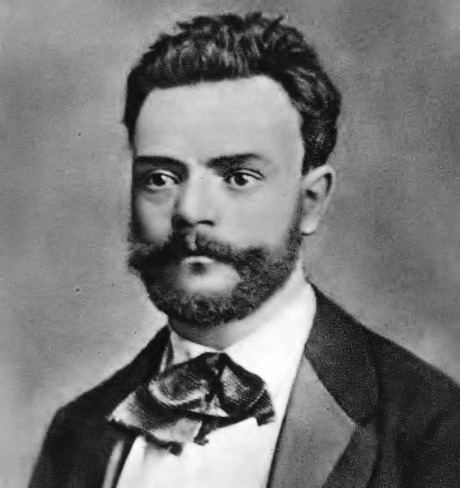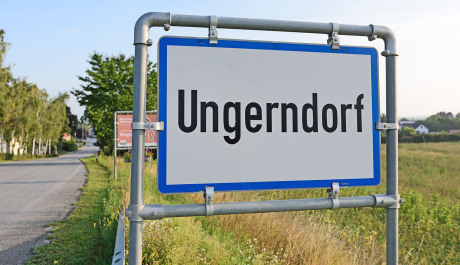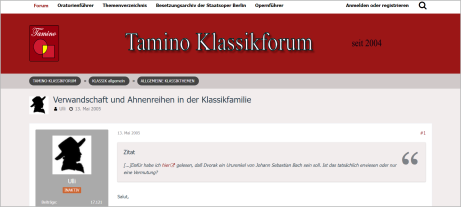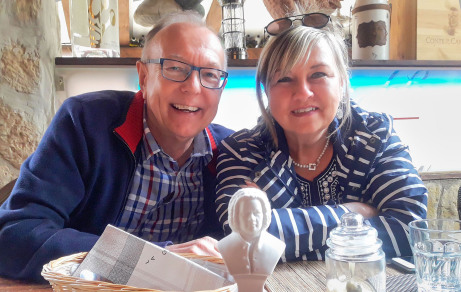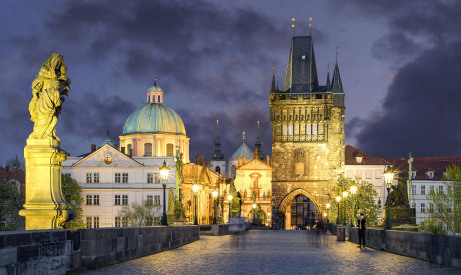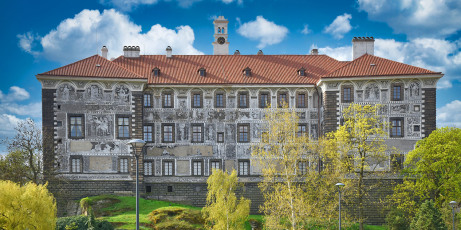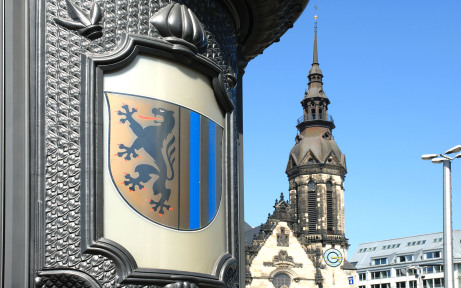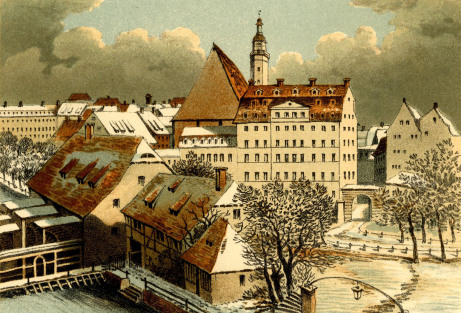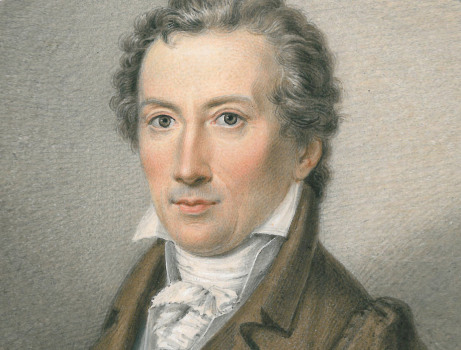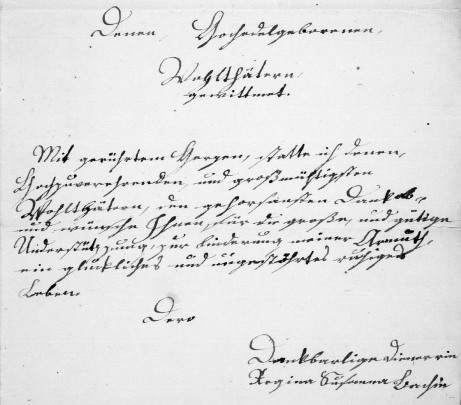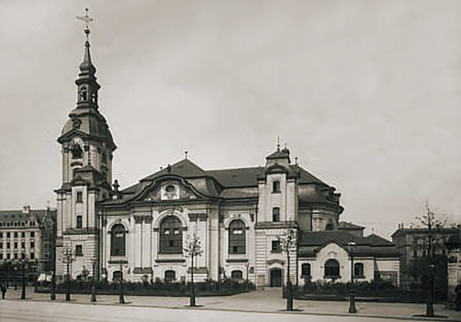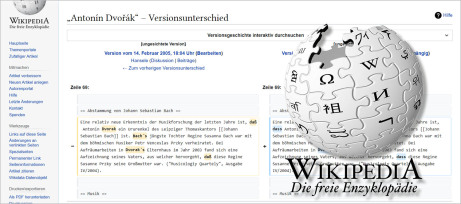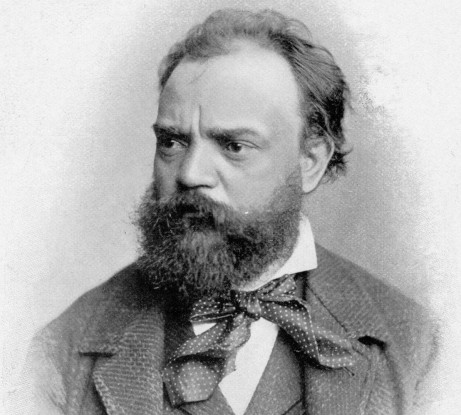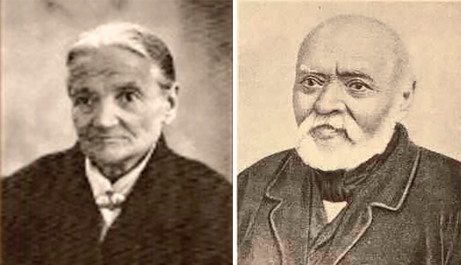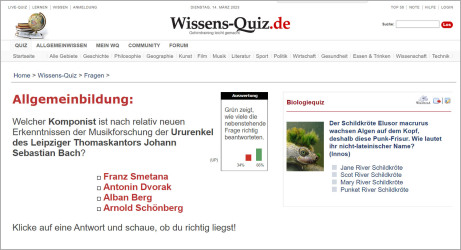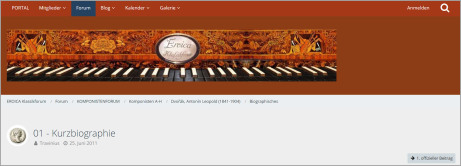Bach-FAQ 133
Antonín Leopold Dvořák, the Great-Great-Grandson of Johann Sebastian Bach?
The 100 most important Bach FAQ.
Antonín Dvořák is the great-great-grandson of his Thuringian colleague Johann Sebastian Bach. But first ... which Antonín Dvořák then? The first, the second, the third or the fourth, so actually ... Antonín Dvořák I, II, II or IV? It's about Antonín Leopold Dvořák, the famous of the four Antoníns. Although: They are – logically – then also all four grandsons of Johann Sebastian Bach ... but with different numbers of "greats" before. You can get to know Antonín Dvořák III, by the way. Here, via the link above... and maybe even in the Czech Republic.
To the point ( ! ) on the relationship between Johann Sebastian Bach and Antonín Leopold Dvořák? Not with me, no. But with a click here you will get – now – directly there. But ... you'd better let me entertain you. With lots of reading on the subject.
Antonín Leopold Dvořák. About 20 years before this page about the relationship between Antonín Leopold Dvořák and Johann Sebastian Bach is published in a prestigious magazine.
It is shortly after the Fourth of Advent 2022, when an exciting mail reaches me. In it is a "Christmas gift with Bach reference" of – for me – almost unbelievable importance. In the meantime, the surprise has found its place on Bach on Bach. It has been rediscovered, like many a peculiarity, especially in the Bach Genealogy. Of course, I do not pretend to be the discoverer. By the way, this surprise was already found about ten years before and published almost as long. But ... already at that time only very few Bach fans discovered this release. And with every year more and more this sensation was forgotten. And today, after more than ten years, this find was "even doomed to lasting oblivion": It was something so special that had lasted 300 years, was then discovered, was presented to the public and from that moment on – slowly, very slowly and yet surely – threatened to disappear again into the depths of history. Even today you can read about it in a magazine from that time. But someone more comes by there.
Bach ... The Bach Genealogy ... And the Joy of Researching
Bach über Bach, my German portal and the international variant in English with your 50 short information in 50 languages – Bach on Bach – are a strange and innovative offer that is definitely different from a book and also from a magazine. If you want to find exciting things about Bach, also special, rare, extraordinary, funny and everything that can't be "transported" by any other medium, my wife and I are the right people for you. My wife Renate takes care of the Bach Genealogy, I take care of the earliest genealogy – before Veit – and of specials. And we are rediscoverers, not discoverers. That is our credo: to rediscover what was once already researched and lost due to lack of broad interest. Not really, but practically. For a variety of reasons. One enormous exception should be mentioned: It is the proof that Veit Bach did not come from Hungary and therefore all the Bachs did not come from Hungary, but came back from Austria. Back ( ! ) to Thuringia. Back to the area of Gräfenroda and Wechmar, only four hours walking distance from each other. And strictly speaking, this final realization also found me. In the form of another mail, in which another Bach fan was able to bring together three components: Veit and Bach and Ungern.
Johann Sebastian Bach did not speak of Hungary and he did not mean Hungary. Up to Carl Philipp Emanuel, the ancestors on the subject of "Great-Great-Granddaddy Veit" kept to the wording that Hans the minstrel (... Hans the Spielman) sent on his way "into the future". As late as 1747, Johann Sebastian Bach told his friend and publisher Johann Gottfried Walther about this Ungern for his "Musicalisches Lexikon". Just as he had already written it down in 1735 and passed it on with probability bordering on certainty. Only Carl Philipp Emanuel would have known that the forefather meant "Hungary" when he said "Ungern".
I Am Also Searching ... But I Let Myself Be Found Just as Well
My achievement: I optimized a procedure, how not I find information via Google, but how I can be found by interested people. A first decisive result was the rediscovery of the emigration of these Bachs to Bohemia. And ... I thought the early departure of the Bachs to Bohemia and then the return from Bohemia was the solution to the riddle. Not discovered by me, but rediscovered by me. "Wrapped up" in the continuous copy of the next biographer from the previous biographer, by the way, for the most part also by the greatest in the Bach guild. The decisive sentence, however, was then my last in my essay in book thickness, together with part 1 about 30,000 words. That's about 170 pages. Roughly, I had calculated it once. Hopefully I remember correctly. But it is also not essential. To this last and decisive sentence: "If a reader and Bach fan should have read up to here, he or she may please contact me, if he or she has essential things to contribute to the topic of Veit Bach". The rest ... is history. My Bach History. And in the meantime official Bach Genealogy, after the former "Bibles of Bach Genealogy" have been outdated for 20 years. All three are the genealogy books of Ragnhild Siegel and Hermann Kock and the purple genealogy book of the "lone fighter in Bach genealogy", Kurt Hermann Frickel. And of course the one by Helga Brück. Still today and already since the beginning of "Bach on Bach" we point to the basic research of these essential and further researchers when we republish their research results, not least for example also the incredible discovery of a first US-American branch of the Bache in Rochester, Minnesota in the USA. All three authors, respectively the Siegl/Kock team failed, however, because of a contemporary phenomenon ... data protection. And here, too, my method of asking people to contact me is effective. The basis: unconditional secrecy for the publication of sensitive data. This is how the most correct and extensive family tree of the musical Bach family has been created until today ... and will certainly continue to be created. In the meantime, it has expanded in width, extended to the time before the return migration to Thuringia and supplemented in our present time by current family members.
My Promise: Honor to Whom Honor Is Due ... And Sensitive Handling of Data
A promise also leads to contact us two Bachs with the then common hobby: According to the motto "Honor to whom honor is due", we present experts who have rendered outstanding services. Like Gisela Brück in Erfurt, like Kurt Hermann Frickel in Niederwerrn, who died shortly before we met, like Mrs. Odrich and Mrs. Thielicke, both also deceased in the meantime, to our personal sorrow. Their research, however, lives on through our portal. With a digital testament hopefully into eternity and that always further up-to-date. Not like many biographies, which are displaced in each case by the newer next. Even if they are not better. Or can be read more pleasantly. This "sharing of the glory" makes next Bach enthusiasts think about sharing the laurels. Only in this way a discovery or also a contribution is "again freshly ( ! ) conserved" for the eternity. This sharing will still be of very great importance on this page ... on which you are reading right now.
What a Surprise for Me!
Back to the Christmas mail in 2022. The surprise has succeeded, and the sensation can be found on this Bach on Bach portal. Where ... will not be revealed. Gladly with a smile. Completely inconspicuously, however, I also read, in the last two lines, a reference to a relationship between Johann Sebastian Bach and Antonín Leopold Dvořák. That's right, the Dvořák. A Czech. A master. However, the actual reason for contacting me electrifies me so much more that I practically read over the reference to Dvořák. Later, I can also faintly remember that I have also encountered this reference before. Sometime. On the Internet. And at that time, other things were probably much more important and so I forgot the early hint, which, by the way, I finally found again and present in more detail much later, shortly before the end of this Dvořák discovery. In the matter of "sensation at Christmas" correspond this Bach fan who sent me the mail, and when this surprise is completed on two website pages as text and "garnished" with pictures, I get to the first "Dvořák hint" still a special corner value, in fact where and when and in which publication I might learn about it some background. Now, by the way, the head is free, and I hope that I can get this article sent as a copy, scan or photo. Because of course such a genealogical connection is an invaluable addition for us. And that with the requested photo of it works in no time. A day later I have three pages, photographed in perfect sharpness.
It Is Proven: Dvořák Is Great-Great-Grandson of Johann Sebastian Bach
Once upon a time, a long, long time ago – it was about two decades ago – when a Bach fan, who is now very respected locally and also regionally, and at the same time working in an exciting public position, spread a sensation. With a complete background to it. A genealogical sensation, which fits so exactly into our search philosophy. This person proves in fact the relationship between Johann Sebastian Bach and his great-great-grandson Antonín Leopold Dvořák in direct descent.
The author opens on it, three-sided, with the keywords "Sensation" and "Finally Proved:". And titles: "Antonín Dvořák Descendant of Johann Sebastian Bach in Direct Line". Below the author's name are two large pictures: Bach on the left, Dvořák on the right. The first four paragraphs are of no importance to our Bach hobby. Then follows, at the bottom of the first page in bold type and dressed up by thick hyphens at the top and bottom, the sentence "It may be considered proven that Antonín Dvořák is a descendant of Johann Sebastian Bach in a direct line!"
Also the fifth section is – for us – then again of no importance. But now follows the part which is probably of highest importance for exactly only two people among eight billion. Because then we have (re)found with our Bach Genealogy and our Bach Mission one more Bach branch not integrated so far and this may not have the quality of the final determination of the return of the first Bachs from abroad back to Thuringia, but it is certainly on a level with the integration of a meanwhile second US-American branch of the Bachs. Quite naturally, a careful review is to confirm the key data, but that cannot be a challenge, so accurately are many of the names, institutions, and processes described in this report. Scientifically of high quality, well researched, excitingly formulated:
Regarding the genealogy: The interconnections between Bohemia and Thuringia / Saxony, the two regions that produced our two protagonists, are manifold. Johann Sebastian Bach's ancestors came from Bohemian lands, as already the baptismal name of his great-grandson Veit Bach attests, whose patron saint is also the namesake of the central cathedral church in Prague. The Bach family's ties to Bohemia did not break off in the first half of the 18th century, and so it is not surprising that Bach's youngest daughter Regine Susanne (1742-1809) married Petr Venceslas Przky, a Bohemian merchant, in 1764, that is 14 years after the death of the Thomas Cantor, and that after the wedding they returned to the banks of the Vltava, where she gave birth to eleven sons and one daughter. Here the Bohemian branch of Bach's family tree was so far lost in the proverbial "Bohemian villages".
Call it coincidence or destiny, in April 2003 a reorganization of the Dvořák archive in his birthplace Nelahozeves (German: Mühlhausen) begins, during which by a clumsy movement the seat cushion of one of the eleven preserved chairs falls out, on which the family František Dvořák used to take the Sunday lunch. It is probably due to the scarcity of money of the innkeeper and butcher that not only horsehair but also "waste paper" served for upholstery, because a corner of a barely legible paper protrudes from the inverted seat cushion, which is immediately handed over to the Philological Faculty of the Petr and Pavel University in Plzeó for deciphering and transcription.
On July 18, 2003, it is determined that the paper quality and watermark date the document to around 1850. The heavily damaged sheet contains a kind of short biography of Dvořák's father in inaccurate German (... the everyday language in this region at that time), the crucial passage of which reads as follows:
"In 1780, after eleven sons, God gave my blessed grandmother Regine Susanne Przky a healthy daughter, who was given to my father Bedrich Dvořák as a wife in 1799. In 1810, I myself was born as the third child of my parents. Since 1835 I have been a butcher and innkeeper in Nelahozeves and in 1836 I brought home my wife Ludmilla. From our marriage two sons were born until today. Anton, the eldest, has nothing but notes in his head; Pavel will become a capable butcher one day."
I am thrilled and of course I want to know more about this super find. And right, not I ( ! ) have found the relationship today. Nor have I rediscovered it today, after 20 years. No, these incredible news have – so to speak – "found me". With the mail of the Bach fan mentioned above.
My Request for More “Dvořák With Bach”
Of course, now I want more: more story, more pictures, more background ... and I want to edit everything ... like I always do. Of course ... that's how you start today ... you google. And I can find out so little with the keywords "Johann Sebastian Bach" plus "Antonín Dvořák" that I am disappointed. I translate my keywords into Czech: I don't need to be able to read the results, it's enough if they are there. And translation software eventually leads me to the goal with my finds in any language. Another disappointment. By the way, I also pass again exactly that entry, which I still remembered so faintly. Today I notice: I am even quoted there myself and the participant also refers to a Wiki contribution in which this relationship is recorded. I cannot understand this meager result.
The Tamino Classical Forum: In it I found a long time ago already the almost unnoticeable echo on the topic "Johann Sebastian Bach's great-great-grandson Antonín Dvořák". Here – above and below – it is as a screenshot, in case this classical music forum once no longer exists. So the content on this exciting topic is "preserved". By clicking here you can still get there at the time when these lines are created.
The reference, which clearly refers to a text in Wikipedia's contribution to "Antonín Leopold Dvořák". And what is written on Wikipedia can actually not be so wrong. Please also note the time stamp: 2005.
This forum contribution to the topic dates around 16 years later than the first ... and here is also my contribution quoted. It is FAQ No. 70 on "Bach on Bach" (... Are there still grandchildren of Johann Sebastian Bach living today?): That Bach was always good for a surprise, that is my text, and I am glad to find it here again. The presenter tries the "revival". Quite by the way, of course, the line of Bach's grandchildren is not extinct: There are just no more grandchildren (... with more or less "greats") with the name of Bach.
Freedom of Quotation, Johann Sebastian Bach and Antonín Leopold Dvořák
Perhaps this surprise has not yet spread because no one has left anything about it on the internet. The most important publication was published on paper, and it is not to be found in the same way on the internet. Now ... in the meantime ... of course it is. * And by the way, how about the copyright on written text that I distribute here?
* Because – above – my reproduction of the text at that time is a representation according to the freedom of quotation (§ 51 UrhG) and I deal with the work intellectually, I may publish a published work even without the consent of the author. The only thing I have to do is to make it clear which text is mine and which is the quotation. That ... is what I can do. Quoted is in blue and italic and partly also in bold as well as in quotation marks. Only the reference to the magazine and the author is not presented. Because I don't want to "drag" anybody – with this small essay in the matter of Bach/Dvořák genealogy – "into the limelight".
I Am Wondering: Am I the Only One Researching Bach Plus Dvořák?
Yes, I am increasingly wondering and write to the author. Assure him that I do not want to play to the foreground. That he is entitled to the credit, that I always do so, with those who accompany me on my way. I ask him for background on the subject, for photos of course, and for his copyrights to be able to present the photos as well. I would like to get in contact with him. And I am looking forward to his answer. Preferably on the same day. You get more and more impatient since Amazon delivers so fast that you wonder how they do it. But not really now. The days drag on and I do not get ultra-fast and also not real quickly ... no message. But there is – in parallel – also much more to discover, because I am of course now also interested in the eleven chairs about which they just read. I am interested in what the university in Plzen wrote, what the Dvořák institutions thought about it. I would like to know if the document, at least as a high-quality scan, has been given a place of honor in many a Dvořák institution in the Czech Republic. Not only that, but I would like to find out everything about this more than exciting constellation.
Waiting in the Internet 3.0 Era
Even a week after I sent my mail to the author, I still don't get an answer ... and I probably won't ever get one. So these other exciting leads are waiting for me. I plan to ask broadly ... not just one municipality, not just one university. But – with the memory of Renate's hints, the non-existence of results on this on the internet and, above all, the absence of an answer from the author, who obviously lives among us at middle age and in the best of health – a worry creeps up on me: Can it be that there is something wrong? A mistake in thinking? Something else?
Win-Win With Dvořák and Bach
I am only briefly very disappointed that there is perhaps no sensational "new territory" waiting for me. That I have not rediscovered anything exciting. That I haven't found a new "caterpillar for my collection". Then my spirit of research brightens up again, because I find myself in a win-win situation: Either everything is true, then we are the only ones who will really ( ! ) publish it. Or ... it is nonsense. Then ... I just make a "story" out of it.
My wife Renate and I: The Dvořáks as a new branch in the Bach genealogy ... what a sensation. © Info
I almost overheard the first hint mentioned by my wife Renate in my enthusiasm to be able to publish such a valuable find again. What did she mean? Several names do not match the genealogy she could extract about Antonín Dvořák from her records. However, this does not "stick" with me, as you sometimes perceive something so faintly that you ask yourself later why you did not immediately give more weight to this or that expression or insight. Alternatively: you simply don't listen! But I should have.
Let's continue working together through the sections in the article that are so exciting for us. So they find the note in bad condition and badly legible and in German handwriting and send it to the Philological Faculty of the Petr and Pavel University in Plzeó, a part of Pilsen. Probably mainly because they might not speak German on site, that is in the museum. However, it is unimportant that the institution in Nelahozeves confirms that the paper is from 1850. It is therefore unimportant, because if the content itself is traceable, then the date of the writing does not matter. But if it is not the correct ( ! ) genealogy, then you have nothing but old waste paper in hand, possibly even 170 years old. Also, the mentioned watermark and its authenticity are rather detrimental to the research, because if the paper is decorated with a watermark, then it can hardly have been waste paper over many decades. Not at any time in 150 years. Finally, however, the author of the article "trips himself up": While the officials of the Dvořák institution could not yet be sure of any content at all – precisely because they perhaps did not speak German – they certainly faced a possible jewel at the University in Pilsen. A proud Czech professor and a herd of students would most certainly have pored over the genealogy of the Dvořáks, which had not changed for decades, and also over the well-known genealogy of the Bachs, which had also not changed in the last 30 years ... in this era. Moreover, this professor in Pilsen would have sought contact with the Bach research in Leipzig and in Eisenach in Germany. There, the research would have been at the level appropriate to the two musical personalities. I want to know more about this and googled on the internet for this university. And find ... no university in Pilsen with this name. Even more ... or in this case less ... I find no Czech university with this name at all and also only one philological faculty at a university in the whole country. Google would like too much to present many Philosophical Faculties with its suggestion "Did you mean ...", but of course they do not interest me at all.
Pilsen: There the Petr and Pavel University Plzeó is significant for me. There, the 170-year-old document concerning "Johann Sebastian Bach and great-great-grandson Antonín Dvořák" was examined about two decades ago.
17 Universities and a Dozen Cities and Places on the Edge of the Vltava River
So I do – in the meantime, until maybe an answer from the author arrives – what I always do when I am very interested in something, but there is no budget available for it: I send off ten mails with my request for free help. And I get no answer at all to five mails, two people write me nonsense, one of the addressees complains, and one or two people I write to lead me to an extraordinarily valuable result. So I write to a selection of universities in the Czech Republic: Not only 10, but 17. These are 1. Charles University Prague, 2. Palacký University Olomouc, 3. Mendel University Brno, 4. Masaryk University Brno, 5. Academy of Fine Arts Prague, 6. Academy of Performing Arts in Prague 7. Janáček Academy of Music and Performing Arts Brno, 8. University of Economics Prague, 9. The University of Pardubice, 10. The Silesian University in Opava, 11. The South Bohemian University in ?eské Bud?jovice, 12. The West Bohemian University in Pilsen, 13. The Jan Evangelista Purkyně University in Ústí nad Labem, 14. The University of Ostrava, 15. The Tomáš Baťa University in Zlín, 16. The Metropolitan University in Prague and 17. The Archives of Charles University.
... and I get a quick reply, just a few hours later: There is no Petr and Pavel University... not in the whole Czech Republic and certainly not in Pilsen.
Why are here two so exaggerated listings, further above the one and also concerning the Vltava towns and Vltava communities further below? Because we – regarding Bach and the Bach Genealogy – not only want to work meticulously, but also want to supply immediately provable sources. No source references with small numbers and a lot of tiny writing at the end of the page or at the end, as usual in books on the last page. Yes ... that's how we are ... yes ... that's how I am.
From the Warm Vltava to the Elbe: 430 Kilometers of Banks
So, where else can you research? In the genealogy: first in that of the Bachs, then in that of the Dvořáks and – you could also start it completely new and thus again – in the church records first in Leipzig, Germany then in the places and cities at the mentioned Vltava banks. A wedding in a place between the bank of the Vltava and the Pleiße does not seem to make sense. Let's start with the Vltava bank. What is the definition of Vltava bank, Mississippi bank, Danube bank? This is the first consideration when listing the localities, municipalities, cities and large towns that are located on a river. Is a place with the local mark only one kilometer away from the Elbe still a "municipality on the Elbe"? Rather no. Why is this relevant to the study? Because it is a matter of searching for people in church records. And it matters whether there are ten towns and villages or 250.
I Like to Exaggerate a Lot of Things
The Vltava is the longest river in the Czech Republic and flows into the Elbe. The Vltava has its source in two headwaters. As the Warm Vltava near Kvilda (... in German Außergefild) with its 143 inhabitants in Šumava (Bohemian Forest) at the altitude of 1,172 meters above sea level ... and as the Cold Vltava. It has a length of 430 kilometers. However, the Small Vltava and the Grassy Vltava do not belong to the source rivers. In Chlum (Humwald), a district of Volary (Wallern), the Warm and Cold Vltava flow together.
The first larger village is Vyšší Brod (Hohenfurth). An impressive 2,621 people live here. It is the first village behind the first reservoir. It is worth mentioning the Vyals Monastery there as a worthwhile tourist highlight. The cities on the Vltava River are getting bigger: The city of Český Krumlov (Krumlov) counts already 12,788 citizens and a highlight is the castle Dívčí Kámen (Maidstein). In front of the city of Budweis (České Budějovice), the Vltava River says goodbye to the Bohemian Forest. Budweis has 94,229 inhabitants. Shortly after, you reach the outskirts of Prague (Praha). Of course, Prague is the dream city on the Vltava River, and it is home to well over a million people. Exactly – now and today when these lines are written – there are 1.335.084 inhabitants. The following town is Týn nad Vltavou (Moldavia) where 7,887 people live. Neznašov (Nesnaschow) is a district of the municipality of Všemyslice in the Czech Republic. However, only 535 people live there.
The next town is then Kralupy nad Vltavou (Kralup on the Vltava) ... 20 kilometers northwest of Prague. Population? 18,485. At Mělník (Melnik), the Vltava finally flows into the Elbe. The population there? 19,579. Later, I hear from a top genealogist with decades of experience that the church records in the Czech Republic are all available online. I save the research in these few cities and places for later ... and look forward to it.
Prague is not the most likely city where some Bachs can be found in the historical church records, but it is the largest in the Czech Republic.
Now I have the idea to ask the absolute ( ! ) expert and specialist on the subject of Anna Magdalena Bach and the twentieth and at the same time youngest child of Johann Sebastian's second wife, Regina Susanna for help: He answers within a few hours and precisely to the point. He is a scientist, I am just an entertainer:
Dear Mr. Bach, just very quickly today, because I'm in a bit of a hurry. But since your questions are quite easy to answer, it is quite possible. There is a death entry from 1809 for Regina Susanna Bach: "A damsel [...] Regine Susanne, Herr Johann Sebastian Bach's Music directors und Cantors at the Thomas School leaves a daughter, which died in the Quergasse [... the name of the street] on 14. Dec. a. 11 o'clock". She was buried on December 17, 1809 at the Johannis cemetery in Leipzig". This entry proves that she was never married. Otherwise, she would have been described as a widow and her husband's name would have appeared. She also had no children. Otherwise, she would not have been called "damsel". Nothing is known about a gravestone. This was also unusual at that time. Unfortunately, I cannot be more detailed today, because [...] should appear on 27.2. I still have to work a little on it and the text should still go to the translator today. Many greetings
Of course, I inform this expert that his expertise is completely satisfying for me, because I am impressed by his knowledge, which is fitting to many other clues and to the brewing thunderstorm in the genealogy of the Bachs. By far this, my research is of course not to be compared with the research to the fake news of a Johann Matthias Korabinsky in Preßburg to the "time of the Bachs in his hometown". And with a time expenditure of only one per thousand research in comparison to the research on the relationship of Johann Sebastian Bach and Antonín Dvořák, but nevertheless some days of careful "digging" and in addition further reading to unbelievable connection of two great musicians, it is all exciting and entertaining.
The above-mentioned top genealogist, who is especially interested also and in every respect in the genealogy of the musician family of Johann Sebastian Bach, writes to me on my inquiry, how long research in all church books of Leipzig, whether there the marriage, which is mentioned above "in blue", takes. He answers, also only a few hours later:
Hello Peter, .... In general, the life story of Regina Susanna Bach is more than illuminated, she was unmarried and died in 1809 in Leipzig, everything can be read under her biography, I think there is nothing unknown. If she was really married to the merchant, why did she die as Bach in Leipzig? The problem with Leipzig is that the books are not available online, and there are a lot of parishes, so you would have to check all of them for the supposed marriage in 1764. I estimate the amount of work here to be about 3 hours. Best regards
Now my research gains momentum and I exaggerate – as I always do – with the lesser pros and cons and here they are compiled:
With this I start my search for probable, very probable and quite special coincidences and the special accumulations which appear only with the addition in the spotlight. Individually noticed, rare constellations are conceivable. But added up, a chain is almost impossible. With this, the evaluation of the content of small inconsistencies, strung together, is to be continued first:
Small, Insignificant Inconsistencies in Nelahozeves
If Antonín Dvořák had been the great-great-grandson of Johann Sebastian Bach, the discovery in 2003 until 2004 would have been a sensation. However, no one – except the journal to which everything on this page refers – published or followed up this particular connection in Germany or in Leipzig: Kurt Hermann Frickel alone would have been highly interested, at a time when we were only beginning our Bach Genealogy "very cautiously".
At that time, no one distributed the author's report about the discovery of the paper leaf in the upholstery of the chair: no professional journal, not dpa (... The German Press Agency), no classical music journal, not the Bach Yearbook and also no music illustrated magazine, except just the edition of the repeatedly mentioned serious publication, but just only as a printed work.
In addition to various specific features, this small chain of sensational coincidences, already mentioned above, finally arises: Firstly, it is not explained how the author of the article got information through the finder, in fact through the movers up to the board of the Dvořák Archives in Nelahozeves. There must have been a connection between the author and the museum at least at that time.
Regina Susanna Who?
A peculiarity is the thin ridge of knowledge of the deeper genealogy of the Bache: first to the least knowledge of the names of the children of Johann Sebastian Bach. It must be a Bach expert who knows not only that Bach had 20 children, but also what Bach's 20 children's names were. That is in a way the following relation: From few names the suitable first name is known to an average generally educated person: For example, of Johann Sebastian ..., Wolfgang Amadeus ..., John. F. ..., Karl Theodor ..., George W. ... and some personalities more. But Regina Susanna ... rather does not ring a bell. On the other hand, this "Bach expert" was not so deeply "in the matter underway", as that he informed himself whether and what is handed down about Regina Susanna. Very quickly, all family trees, whether in biographies or in the Bach archive and also in further Bach reading would have quite certainly led to the realization that he had to dig deeper into the matter. What obviously did not happen.
Even the wording of the name of Regina Susanna – assuming she had been married – is completely easy to research. The family tree of Antonín Leopold Dvořák has been researched for a long time, is well comprehensible even today and is well preserved in church records and just ... simply correct. But what does not "appear" in one of these Czech church books is the name Regina Susanna, still as noted in the document from 1850" "Regine Susanne" with two " e ". She should be present, at least in one of the cities or places along the Danube, as a great-grandmother of the super-composer Dvořák. And besides that, there should be a grandfather of Antonín Dvořák to be found there: Bedrich. But he is not to be found in the whole Czech Republic. Bedrich was simply not "our" Dvořák's grandfather. These were the first two essential clues, which I almost overheard when my wife supported me very early in the common search: Well, she is still much more conscientious than I, I am only really fit in the matter of "Veit Bach's ancestors".
What a Chair, What a Find: A Document Instead of Horsehair
Then we move on to the discovery of the document. At first, this paper seems to have existed for a full 150 years between the year 1850 and the 2003 find. From simply being written down in 1850, when this mini family chronicle could have been written a second time, the document became more and more exciting over time. When it made its way into the seat cushion is unknown and also unimportant. What does seem important, however, is that if the document was of substantial family value, how did it end up one day as a horsehair replacement in the chair? Directly, from where it was previously kept with the family's unique, important documents?! This is unlikely. Alternatively from a bump of scrap paper collected sometime between 1850 and 2003? That's also unlikely that pure waste paper was kept that long in the first place. A third option is that the replacement of upholstery occurred immediately after it was written down. This also seems quite strange, because then this paper could have been left blank and used for cushioning immediately. This also seems strange. A fourth possibility, is of course a deposition as a kind of "time capsule" or as a kind of "message in a bottle" ... long live the conspiracy theory.
In Nelahozeves "happened" the more than cool discovery. Not in the building above, that's just a nice motif in this city, but in the Dvořák Archive. © Info
Moving on to the find: So there were eleven chairs that were moved from one place to another, maybe to another place after that. Or even back again after the rearrangement. "Completely by chance" then exactly this seat cushion fell down after presumably many decades and a "twisting", because it was probably not properly fixed. As the only one. Next then also this jewel – although damaged and also hardly legible – but just interesting, explicitly looked out. Also, that it is recognized as a value is not a common feature, because one has not simply mounted the seat cushion back on the wooden frame, but examined the filling.
However, nobody has then genealogically ( ! ) – not even meticulously – investigated, although one would have had to investigate only round 15 current years in church volumes. And that in only round 11 cities and places in the Czech Republic ... and one single year in Leipzig, Germany: because the year of the wedding was clear: In 1799 the granddaughter (... the daughter of Regina Susanna) of JSB marries her Bedrich Dvořák. In 1810 (... actually in 1814) Frantisek Dvořák was born. And none of the church records listed in this section were burned, lost or destroyed by war.
So now to the core competence of my wife Renate: Researched to the point, specifically in the Czech Wiki article: The grandfather of Antonín Dvořák was simply not called Bedrich, but Jan Nepomuk Dvořák.
Crystal clear, Antonín Dvořák's grandfather was named Jan Nepomuk.
Here again, Antonín Dvořák's grandfather was named Jan and not Bedrich, as you can see on this birth certificate.
And Antonín Dvořák's mother was simply not called Ludmilla, but – according to the entry in the church register (death certificate) – Anna.
Also crystal clear: Antonín's mother was called Anna. And not Ludmilla.
And what is now really and additionally "hilarious": The author of the family history around 1850 probably did not know himself that he was not the third-born child of his parents, but the ninth. In addition, he dated his own birthday by four ( ! ) years wrongly. Well, in the heat of the moment, that can happen sometimes.
This brings us to an even more detailed description of the life situation of Regina Susanna Bach (... daughter of Anna Magdalena Bach and JSB), which we owe to Maria Hübner (Leipzig) in the Bach Yearbook 2002. She deals in detail with whether Regina Susanna Bach could have been married at all. If not, there is no need to go into detail about the 13 children. Here is the link to it.
Or download it here:
PDF-Dokument [2.4 MB]
None of certainly twelve super genealogists over the centuries on Bach family matters has found any evidence that Regina Susanna, twentieth daughter of Johann Sebastian and thirteenth child of Anna Magdalena Bach was married.
This – Well Researched – Is What It Says on the Internet
After Bach's death, the Leipzig Bachs were not only without a financial provider, but even worse: because they had used a municipal apartment during Bach's lifetime, in fact in the Thomas School, they had to move out as well ... on top of all their suffering. Regina Susanna was eight years old at the time. At least the new apartment in Hainstraße (... name of the street) was not far away, so that the "remaining Bachs" at least did not have to get used to a completely different living environment. In fact, Regina Susanna and her older sister stayed with their mother Anna Magdalena Bach. In the middle of the 1760s, her half-sister Catharina Dorothea may also have returned to live in Leipzig; in 1771, her presence in Leipzig is attested in documents. For several years, the sisters were still able to live on benefits that had originally been due to Anna Magdalena, possibly also on another small allowance and some additional money from Carl Philipp Emanuel Bach in Hamburg.
After the death of Johann Sebastian Bach, the remaining family of the Thomas Cantor could of course no longer stay in the apartment in the St. Thomas School.
In May 1800, Friedrich Rochlitz, composer and music writer, initiated a fundraising campaign for the last of the Bach daughters still alive with an appeal in the Intelligenzblatt zur Musikalischen Zeitung, published by Rochlitz, which probably resulted in a notable improvement in her living conditions. In it, Rochlitz describes the living situation with the words: "This daughter is starving". Certainly, this term indicates poor conditions even at that time. After the collection, Rochlitz prints a list of the donors and a received acknowledgement from Regina Susanna (... you will encounter this receipt below). Another initiative by a piano maker Streicher extended the collection even to 1801 and yielded another 200 thalers and Rochlitz reported on this as well. Regina Susanna's acknowledgement, which however did not correspond to the published one, is still preserved today. Regina Susanna lived in a prestigious residential area at that time. The fact that Regina Susanna also received 16 Groschen monthly in 1760, half of the university alms paid to Anna Magdalena before her death, is uninteresting for our considerations, because this was in addition to the emoluments before her marriage. However, the fact that she was still receiving 12 Groschen a week as "Damsel Bachin" on October 12, 1767, is of utmost importance for us, because that was then three years after the marriage.
He started the collection for Regina Susanna when she was "starving" in Leipzig: 100 Thalers were collected. The following year, another collection was made for Bach's youngest daughter and even 200 Thalers were the proud result.
And why is the last record important for us? Firstly, because she is explicitly designated as a "Damsel." At this time, she is – according to this document in 1767, which is three years after her "marriage" – officially – no longer a "Damsel". Secondly, at this time and according to the document found in the seat cushion, she no longer lived in Leipzig, but on the banks of the Vltava. Finally, thirdly, she gave birth to a total of 13 children, was thus net ten years "busy", rather eleven, even more likely twelve. 1768 dates a document about a grant of four Groschen "wood money" for Damsel Bachin", which doubly indicates that Regina Susanna could not be married at this time with the mentioned Petr Vencelas Przky, because then she would no longer have been called "Damsel Bachin". Theoretically, she could not have been divorced from Przky either, because then she would have given him the common 13 children in only four years: biologically hardly possible and she would not have been called Bachin then either. Finally, her husband could not have left her life prematurely, because even then she would presumably have been called Przkin, would no longer have been listed as "Damsel" and how could she then have had the 13 children. A document from 1781 proves the halving of the weekly alms to only six Groschen. It is noted that this amount was included until her death in 1809. This would probably not have been the case if she had stayed at the Vltava River in the Czech Republic. In addition to the mentioned financial sources, there was also the foundation Erdmuthe Sophie Frege, from which Regina Susanna received eight Groschen each four times a year, for the first time in June 1795, and this beginning is strange and for the last time in 1809.
In handwriting – finally then also printed in the newspaper – Regina Susanna Bachin thanks for the donations so that she no longer had to "starve" ... which she then no longer had to do.
Regina Susanna was buried in the St. Johannis cemetery next to St. Johannis Church in Leipzig, in fact in the cemetery where her father was once buried. And not on the banks of the Vltava River.
So much for the genealogy of Regina Susanna.
Interesting regarding this collection is also the dissertation of Christoph Öhm-Kühnle from 2008. From page 107 (Excursus: The appeal for donations for Regina Susanna Bach 1800 / 1801 and its aftermath) you can read a detailed description of this collection.
PDF-Dokument [11.1 MB]
By the way: I, too, could "pull your leg" with a made-up story. How do you know that this magazine report ever existed? It can actually be proven. In this Tamino Forum there is a link to Wikipedia. That is, to the German contribution about Dvořák on Wikipedia. If you click on this link, you will land on this page, on which an excerpt of the printed publication is quoted. Better ... was ( ! ) quoted. Because the topic and the sensation were once actually published on Wikipedia. But then removed again. And that is still recorded today (... you can do that too by clicking on the link "version history") ... probably for eternity. Also exciting: The writer refers to the source, which today also cannot be found on the internet, in fact the "Musicologiy Quarterly" and finally to the volume IV/2004. I could not find an offer of this name either. Meant here could of course be "The Musical Quarterly" of the Oxford Academy, and it is spelled just a little differently. And it is likely that the Wikipedia editor did not find the text there, but referred to the paper article at the time. Because, of course, I searched the journals at "The Musical Quarterly" for the entire past century and found nothing for all conceivable keywords, not even in the corresponding year.
This is ... you recognized it ... a photo composition. To make it look nice. In reality, the giant Wikipedia ball is not sitting on the right. You can tell by the date: In 2005, two Wikipedia authors had an "exchange" about spelling. Shortly after, when everything was grammatically and stylistically perfect ... all the fresh content about Dvořák was discarded and removed, as you can still see today: You just don't see any of it in the article anymore. © Info
The penultimate highlight is of course the remaining of the original ... although this is of no importance for our consideration, a single photo – and already in 2004 we were in many cases able to scan, photograph or copy – a single photo would have been enough to prove the authenticity of the complete story. But much more interesting, of course, is the successful sale of the original to the Antonín Dvořák Trust in Virginia Beach. It's a shame that this trust doesn't exist either, unless it's invisible online. At least there is ... Virginia Beach in the USA. That much is certain.
Let's let the author himself – some more paragraphs in the then article later – again personally "speak out" when he reaffirms in the penultimate paragraph:
"... Many examples could be given testifying to Dvořák's rich compositional heritage from Johann Sebastian Bach, as is done in this ... with composers such as Schoenberg, Webern, Brahms, Bruckner and Mendelssohn. But in the case of our Czech composer, it is not only a matter of spiritual, but also of blood relationship: Antonín Dvořák was the true great-great-grandson of Johann Sebastian Bach. ..."
Why am I doing this ... this editing, now that it has been established that this message in 2004 is Alternative Truth?
Well, firstly I want to entertain you. With facts, with exciting things, with curiosities ... and for some Bach fans this possibility of relationship, which has been haunting the media for almost 20 years now, is definitely part of it. The serious Bach elite has already investigated at the time of the publication, the nonsense will certainly not be reissued ... but no one ... just found pros or cons on the current internet. That ... is now different, because I would like to spoil my "baby" of course so that it appears to the keywords "Johann Sebastian Bach" with "Antonín Leopold Dvořák" preferably on the position 1 on the page 1 on Google. Let's see if that works.
Yes, finally ... that's how we know him best. Antonín Leopold Dvořák, who is not ( ! ) the great-great-grandson of Johann Sebastian Bach.
But then I also wish that the confusion which the two "experts" Carl Philipp Emanuel Bach (... only as genealogist) and Korabinsky (... as a goofy) around the origin of the Bach "have perpetrated" does not happen again or similarly. So ... to this I would like to contribute at least. By the way, it happened similarly to Wilhelm Friedemann Bach, who ended in a historically bad slander only because of a novel of an unsuccessful writer. In fact, such nonsense is quickly "exposed" on the internet via the Ancestry platform and less "guarded" Wikipedia contributions and subsequently spreads virally. With a concluding own contribution in the Tamino Classical Forum I would like to conclude my research after the posting of this work with it.
The parents of Antonín Dvořák, but not related to Johann Sebastian Bach. Whether it was already noted in the then Wikipedia contribution regarding Antonín Dvořák, that the parents of the Czech super composer, on his mother's side, were already known. One could bring it in experience, but sometimes it must be enough.
Epilogue
Finally, a closing word, directly to the author of the lines printed at that time: Certainly, it was the same reasons that at that time prompted the writer from Preßburg, Korabinsky, to create such exciting genealogical confusion. But certainly not with his "success". I profit from it today, because this nonsense results in another nice page on my website. For the surely on two hands countable interested people, who are looking here now in the future for an answer to this Alternative Truth via Google, it is perhaps a pleasant entertainment ... and also to smile. What I do not want is to put you in the limelight with this, my assessment. After all, I specialize in the discipline of "finding", and – to new members of this family – "keeping personal secrets". And so I believe: Practically all living adult Bach fans have already taken note of your "discovery" at that time and have – at best – quickly classified it as Fake News. Of them, not a single person will want to consume any further on the subject of "Dvořák vs. Bach". So these 99.99 percent of all Bach fans don't look past here anymore. The topic has been "cooked" for them for a long time. And the few remaining interested? They will not find out who you are. Because only the printed article leads to your person. And because at that time not everything was deposited in parallel also on the internet, links on Google lead only to two pages. This is once Tamino, the classical music forum ... and there it does not go further, respectively also again only to me. And just to Bach on Bach, in fact to FAQ 132 and 133. In this sense I thank – with a wink – for this top thought-out, round fairy tale of Antonín Dvořák and his great-great-grandfather Johann Sebastian.
The signature of the master. © Info
Epilogue Number 2
After exactly twelve days and 57 minutes, I finally receive an answer to my mail. From the really respected (... and I mean it!) author of the article in this totally conservative publication 20 years ago. Very politely, but really ultra briefly he means: "The text is satire". However, the most recent pages on my website – the one you are reading now – FAQ 132 and FAQ 133 had already been researched, written and laid out, plus the pictures had been edited. It is now ... also satire ... but I let you all know that herewith with pleasure.
Then let's do it like this: Maybe Korabinsky's hint at that time that the Bachs came from Hungary was also satire. Finally, it could be clarified why this Korabinsky fooled the Bach world so many decades ago and still fools today. And once again we google ... one last time ... now to the topic, what satire actually is:
Let's use the ten best definitions, in fact on the Google results page1: On a portal it is about an "artistically designed prose text, through which persons, events or occurrences are denounced". Secondly, satires have the following characteristics: "It is a mocking and/or comical presentation of criticism. Obviously bad things are presented as positive things". Third, "It is an exaggeration or an understatement as a stylistic device". Fourth result: "Satire is a representation form, in which in particular persons, events and grievances in exaggerated form by exaggeration or understatement are drawn into the ridiculous". Fifth result: "Today, satire is understood to be an artistically designed joke". Sixth result (... an excerpt, as it was already five times above, of course also only excerpts) and particularly exciting: "What a satire is not allowed to do: falsify facts. And spread untrue facts". No. 7: What is satire allowed to do today? Today it may do everything, if the message is to be transported, in order to improve thereby "the world". Result number 8: "Satire is protected by the freedom of opinion and also by the freedom of art". The ninth result (... tadaa ... Wikipedia ...): "Satire is an art form that denounces, ridicules or criticizes events. Up to the ridiculous and absurd. No provision applies to the totality of all satires". And the "king result"? It is number 10: "In the first step, satire must be recognizable as such. Satire is not always understood as such." This is the statement of the law firm Gulden Röttger Rechtsanwälte. In the article "What is satire?" under section heading 4, we read: "How do you check a satire legally?": "Firstly, satire must be recognizable as such ... and satire must, accordingly, put up with the question of whether the satirical contribution is suitable for improving the world. If the work already fails at this, then we are dealing with comedy at best" (... last sentence comes from the section "Satire and Law Today").
Well, these ten results are super cool. Okay, then probably all Bach scientists, Bach experts, Bach genealogists and some, few Bach hardcore fans recognized the project as satire. Only I, as the only one of today's eight billion people on the whole earth – oh better ... in the whole universe – fell for it and didn't recognize that it was about "satire". How embarrassing, how embarrassing!
And still one on top ... because whether perhaps the whole report became at that time only after its publication satire, that may the inclined reader now assemble for himself.
Aha ... it spreads. Here is the original link.
Excuse Me ... It's Not Yet Over?
Once upon a time, a long time ago, shortly after the turn of the millennium, a fairy tale, short and intense, "enchanted" many interested people. The fun, the astonishment, the doubt and some head shaking has reached however round twenty years later certainly finally all interested ones and only a tiny – really homeopathically ridiculously small – circle of persons remains, who finds here and from today in the meantime an answer to a history, which sounds unbelievable and is not true. And finally this fantasy is thus preserved for eternity for the next individuals in search of a hair-raising connection between Johann Sebastian Bach and Antonín Leopold Dvořák. To all – really all ( ! ) – involved my heartfelt, sincere thanks.
Plus, in this forum meanwhile it's clear, too.
. . .

